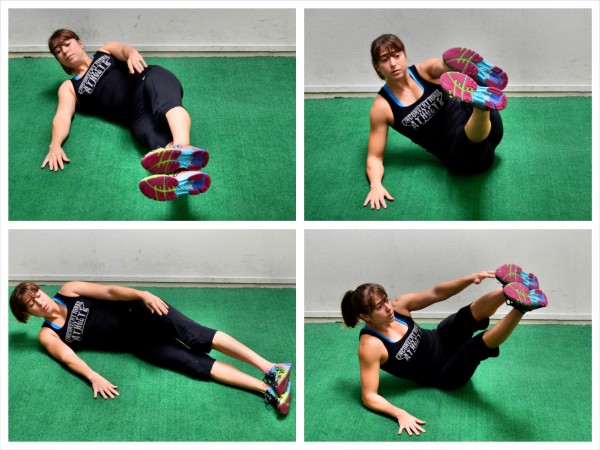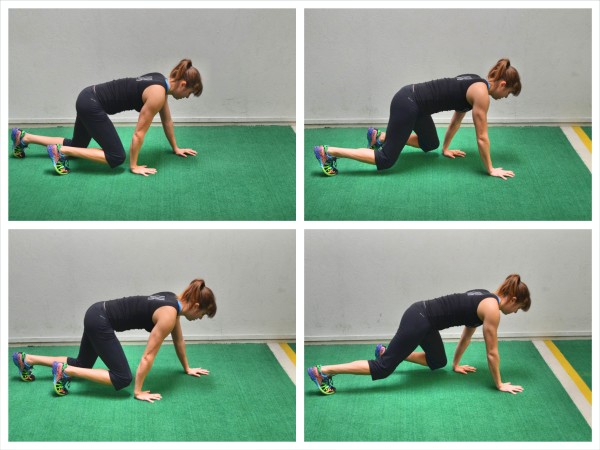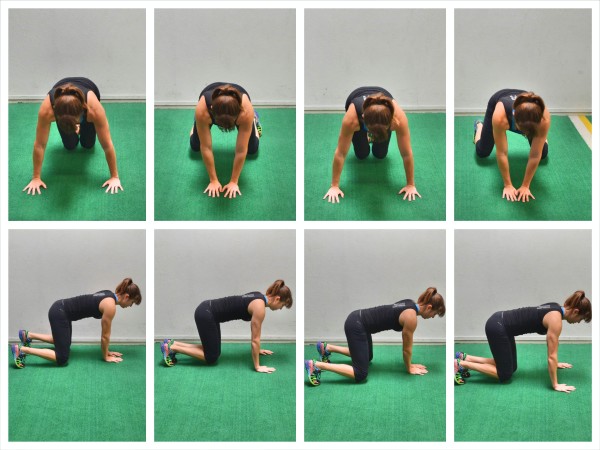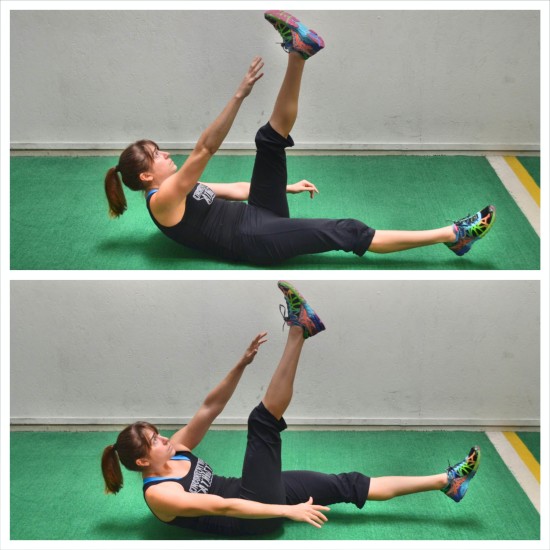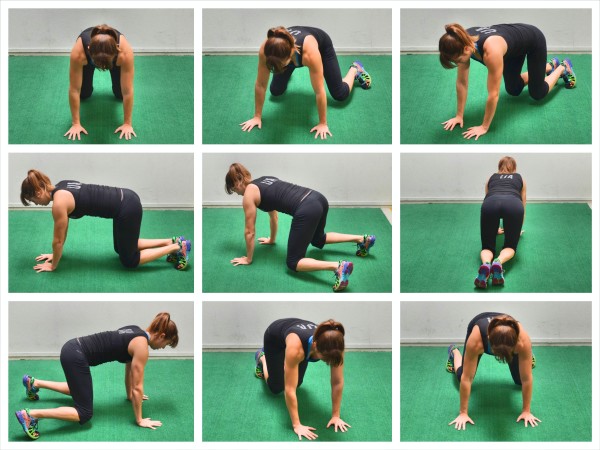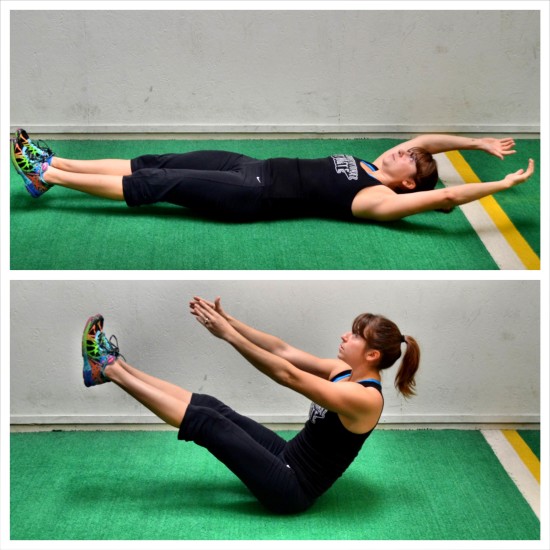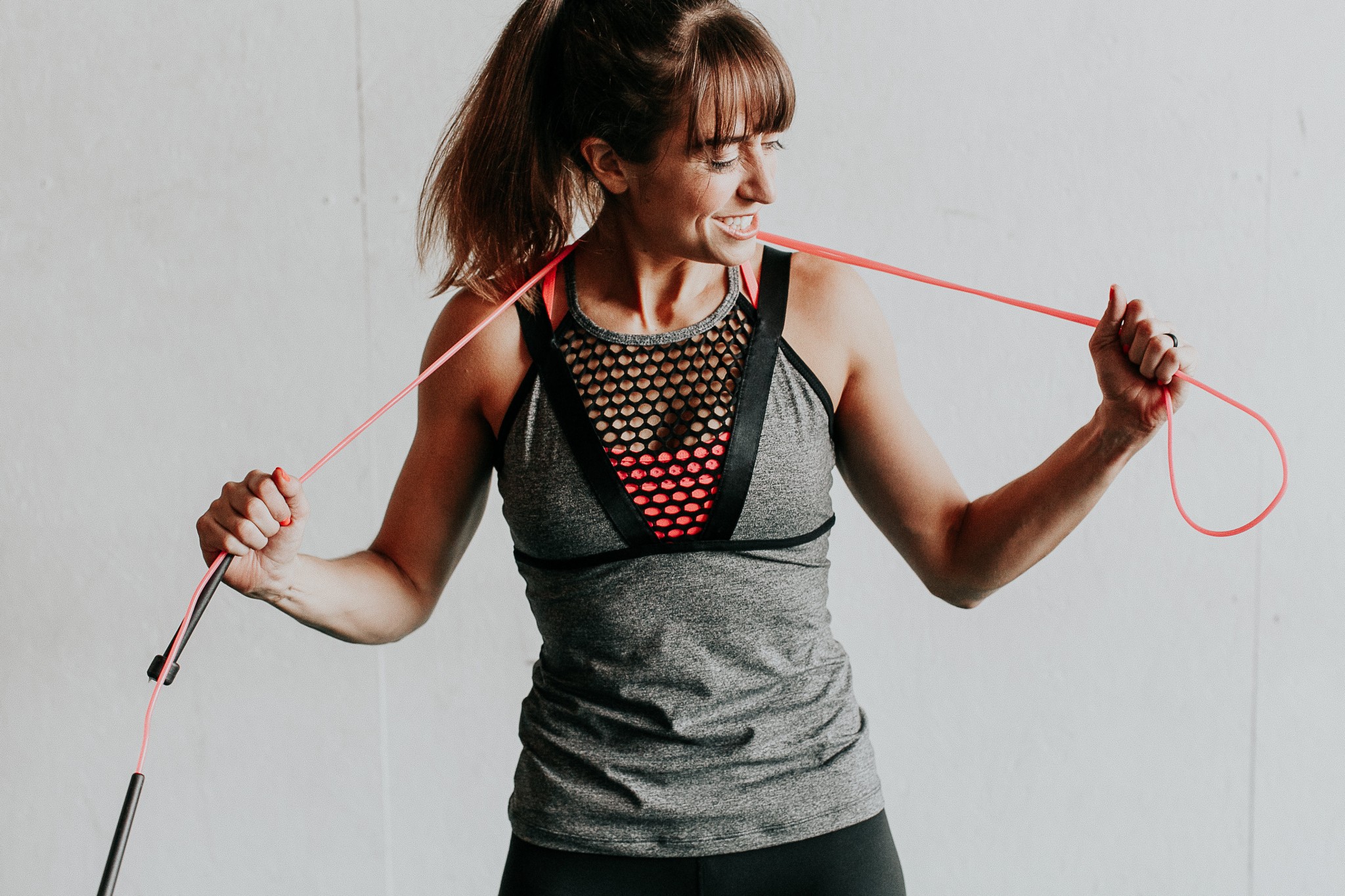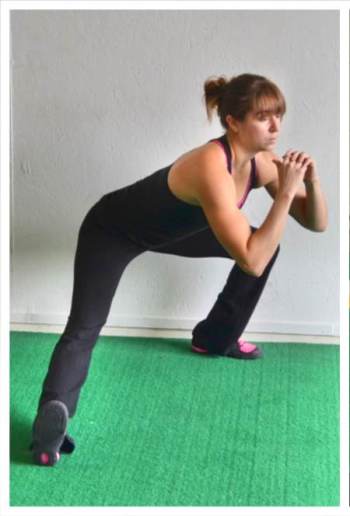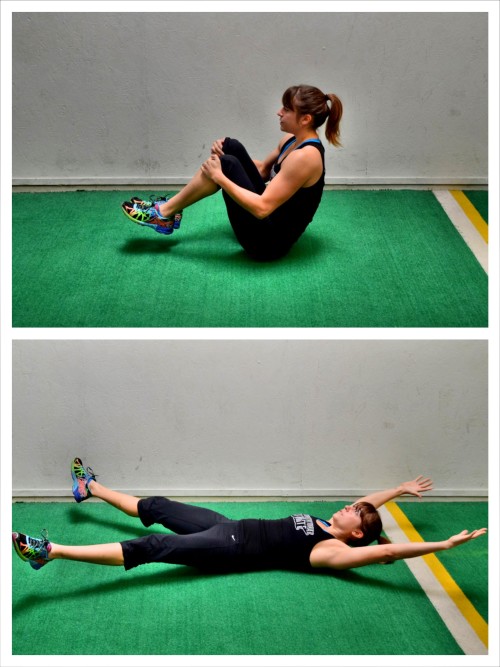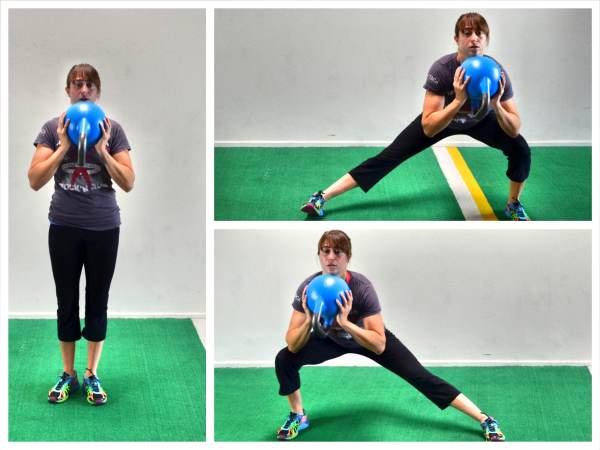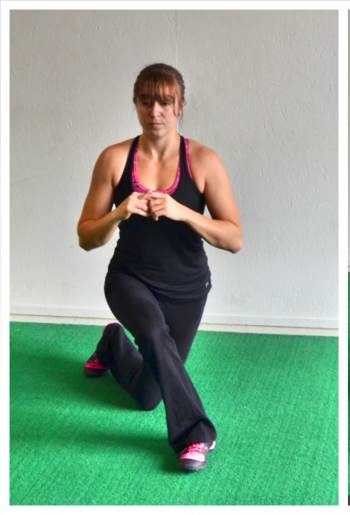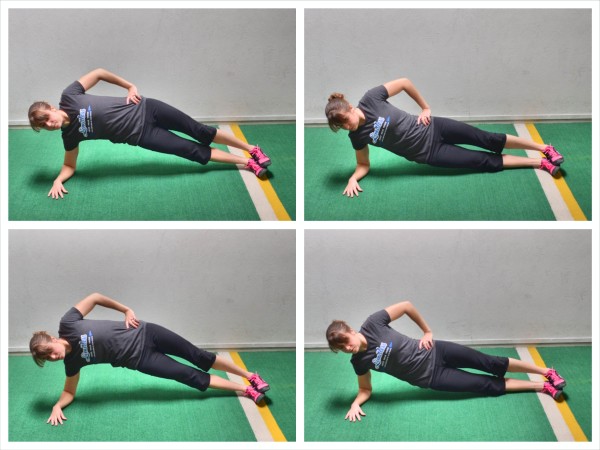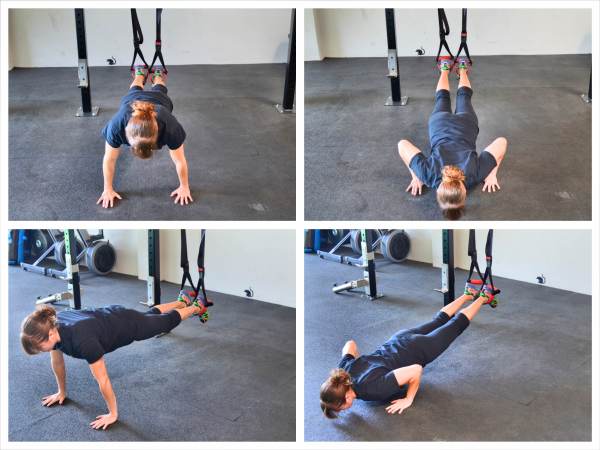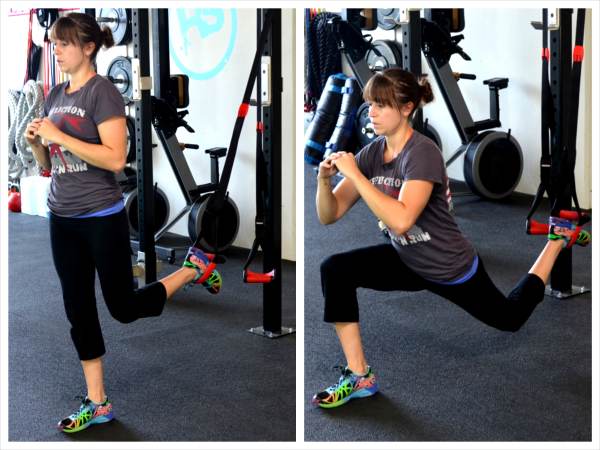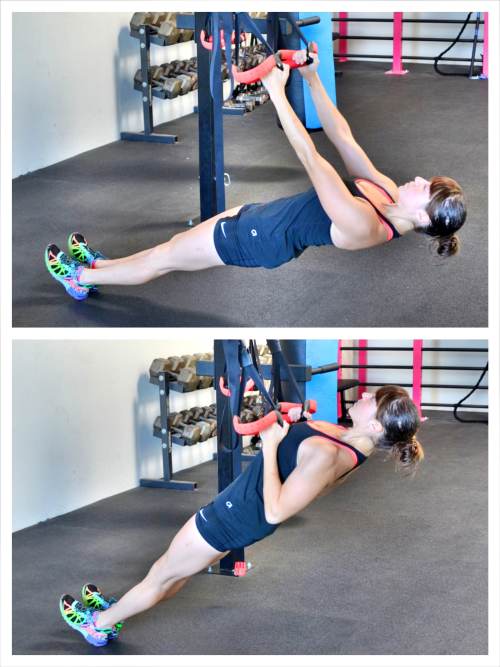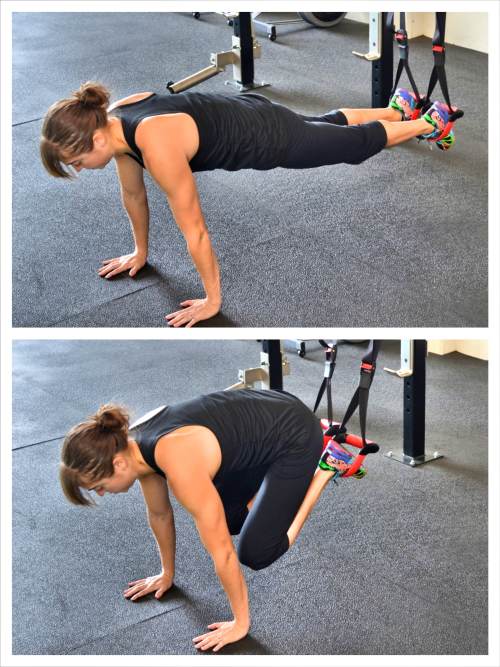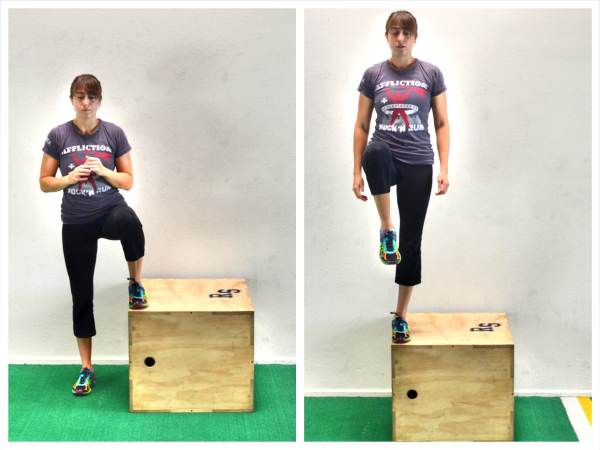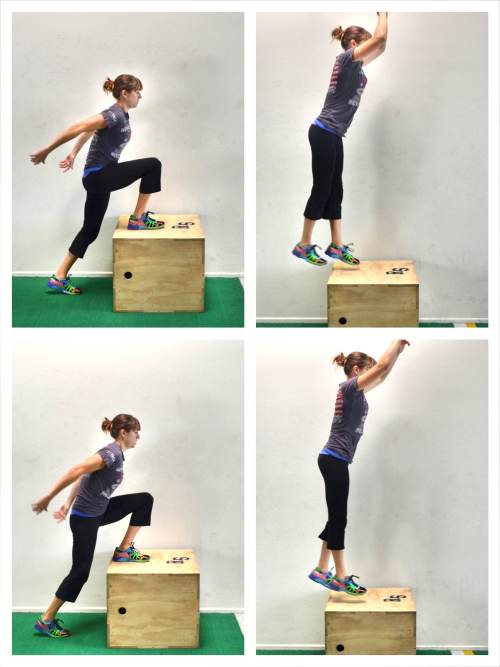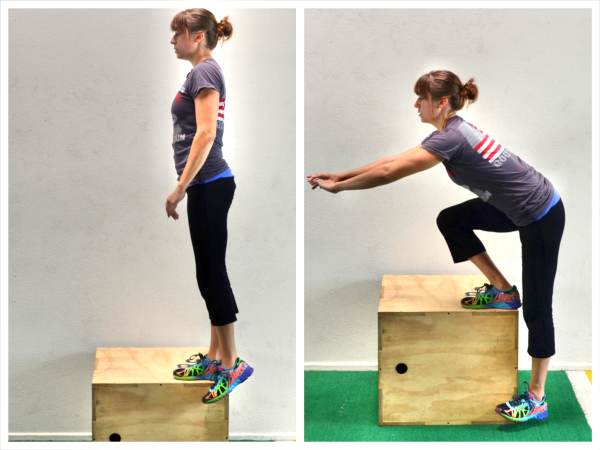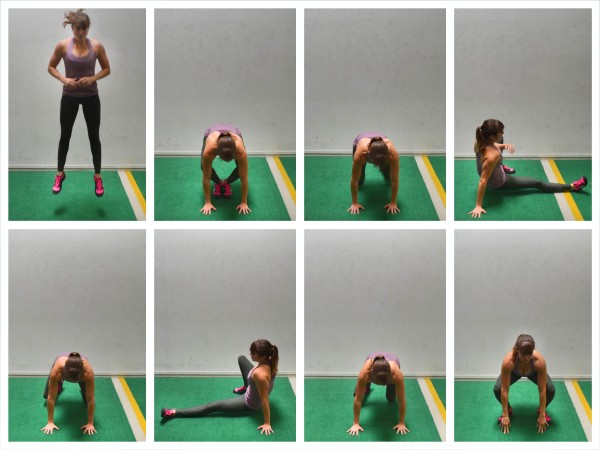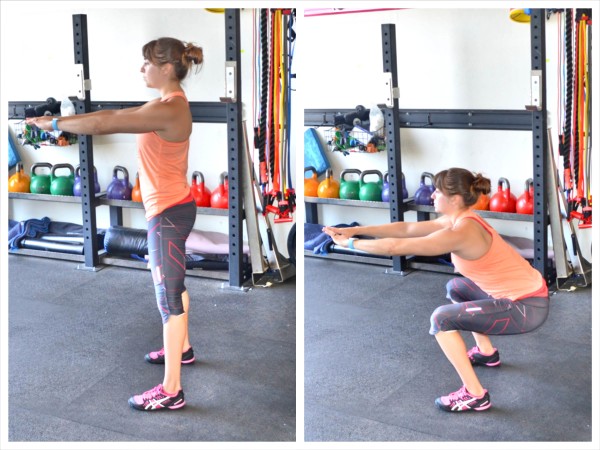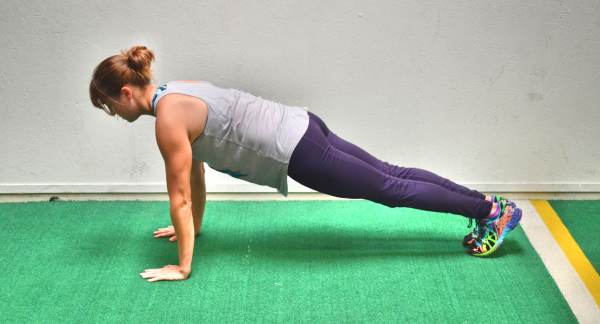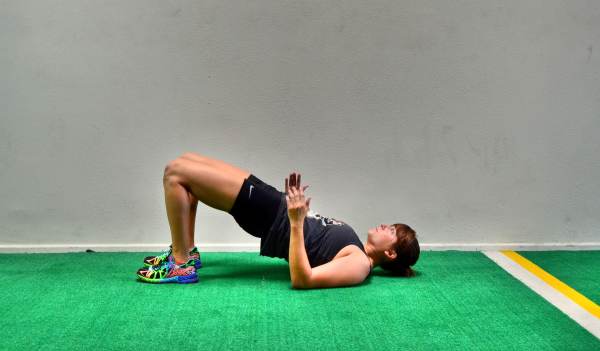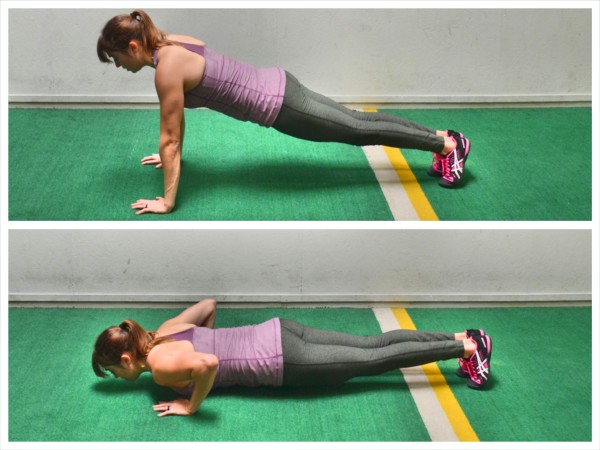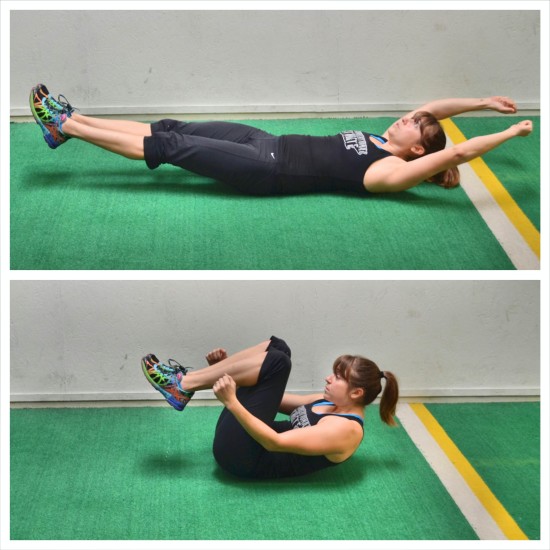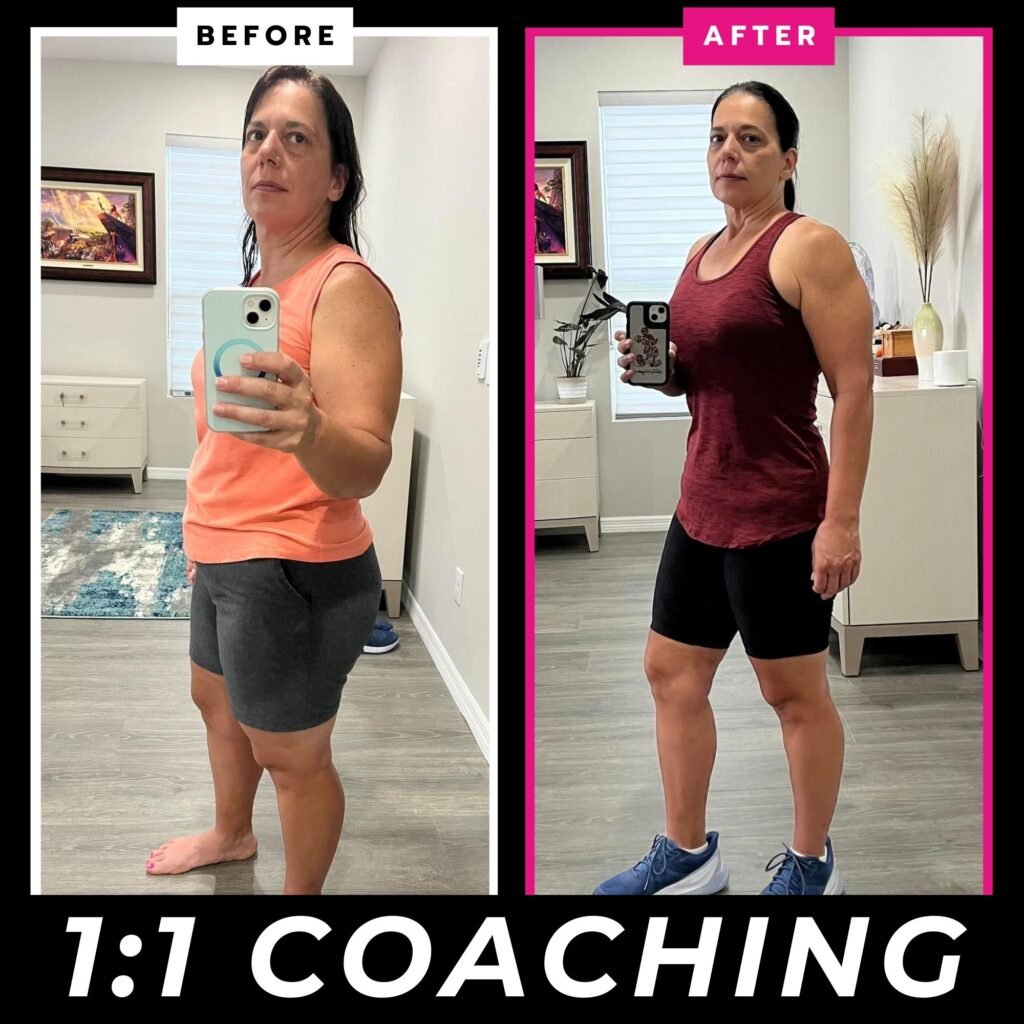
by Cori Lefkowith | Dec 6, 2013
WARM UP
Stretch and Roll Out:
Calves
Hamstrings
Quads
Groin
Hips/Glutes
Chest/Shoulders/Traps
WORKOUT
Perform 3 rounds of each of the circuits below. Rest half the time to the same amount of time it took you to complete each round. Rest 2-3 minutes between circuits.
CIRCUIT #1:
20 seconds Resisted Sprint
20-50ft each way Forward/Backward Bear Crawl
5-15 reps each side Oblique V-ups
CIRCUIT #2:
20 seconds Resisted Sprint
20-50ft each way Lateral Bear Crawl
10-15 reps per side Alternating Leg V-ups
CIRCUIT #3:
20 seconds Resisted Sprint
3-5 reps each side Circle Crawls
5-15 reps V ups
COOL DOWN
Stretch and Roll Out:
Calves
Hamstrings
Quads
Groin
Hips/Glutes
Chest/Shoulders/Traps
NOTES:
This is a great small group or partner workouts because one or two people can work as their partners hold the bands to do the resisted sprints and then they can rest as their partners go.
Beginners can also do unresisted sprints or you can add resistance by dragging a chain or sled if you don’t have a partner.
EXERCISE DESCRIPTIONS:
Resisted Sprint – A resisted sprint is a sprint for time not for distance. Your goal is to do as much work as possible in the 20 seconds. If you are doing a resisted sprint with a band and a partner, you are going to do almost like a high knees sprint in place. You will be moving forward while your partner is pulling back. You want to focus on driving your knees up and down as quickly as possible not on moving forward quickly. Beginners may want to do this unresisted and work on form while advanced exercisers or people doing this workout without a partner can drag a chain or sled for time.
Forward/Backward Bear Crawl – Set up on your hands and knees with your knees under your hips and your hands under your shoulders. Then flex your feet and lift up onto your toes. Take a step forward with your left foot and right hand, keeping your knees close to the ground and your back flat. Then step forward with your right foot and left hand. Keep alternating moving the opposite arm and opposite leg together. Once you’ve crawled forward the 20-50ft, you will then reverse the crawl. Take a small step back with your right foot as you step back with your left hand. Take small steps, especially moving backward. If you reach too much with your leg, you are going to put more strain on your shoulders and your movement will get off. The opposite arm and leg need to move together. Keep your knees close to the ground as you move backward. Beginners may need to perform a baby crawl from their knees and hands.

Oblique V-ups – Lie on your side with your bottom arm out in front of you just below shoulder height. Angle your straight legs a bit out in front of you, stacked one on top of the other. Keep your legs together. V up on your side reaching your top hand toward your toes. Lift your legs up as high as you can as you sort of prop yourself up on your bottom arm. Relax back down and repeat.

Lateral Bear Crawl – Set up on your hands and knees with your knees under your hips and your hands under your shoulders. Then flex your feet and lift up onto your toes. Place your hands close together and your feet about shoulder-width apart. Then step your left hand to the left so your hands are apart as you step your right foot together with your left. Then step your right hand to meet your left hand as you move your left foot to the left. Keep moving the opposite arm and leg laterally until you’ve completed your 20-50ft then crawl laterally back.

Alternating Leg V-ups – Lie flat on your back with your legs out straight in front of you. Beginners will rest the leg not being raised up on the ground while advanced exercisers will keep both feet off the ground at all times. Lift one leg up toward the ceiling. Crunch the upper body up and reach the opposite arm up toward the toes of the raised leg. Then lower that leg and lower your upper body down. Raise the other leg and the opposite arm to touch it as you crunch up. Keep alternating sides.

Circle Crawls – Set up on your hands and knees. Flex your feet and lift up onto your hands and toes. Your knees should be under your hips and your hands should be under your shoulders. Pretend their is a string attaching your belly button to the ground. You may even want to put something on the ground under your belly button to keep you centered. Then begin to circle over that spot. Do one full circle one direction then switch and do a complete circle the other way. To move in a circle, you will take a step with the opposite hand and leg. Make sure to move both your hands and feet. You do not just want to move your feet and circle around your hands! Beginners may need to do a baby crawl on their hands and knees to start.

V-Ups – Lie flat on your back with your legs out straight in front of you. Reach your arms overhead. Keeping your legs out straight, lift your legs a bit off the ground. Pike your legs up toward the ceiling as you crunch your upper body up and reach your hands up toward your toes. Try to crunch your upper body all the wall off the ground so you are basically sitting on your butt. Beginners may not be able to crunch up that far and may need to bend their legs a bit. More advanced exercisers will v up onto their butts and keep their legs straight. They will also not touch their heels to the ground between reps.


by Cori Lefkowith | Dec 6, 2013
WARM UP
Stretch and Roll Out:
Calves
Hamstrings
Quads
Groin
Hips/Glutes
Chest
Back/Lats
WORKOUT
Perform 3 rounds of each of the circuits below. Rest half the time to the same amount of time it took you to complete each round. Rest 2-3 minutes between circuits.
CIRCUIT #1:
20 seconds Jump Rope/Double Unders
8-12 reps each side Backward Rotational Lunge
10-15 reps Cherry Bombs
CIRCUIT #2:
20 seconds Jump Rope/Double Unders
8-12 reps each side Side Lunges
3-5 reps each side Circle Crawls
CIRCUIT #3:
20 seconds Jump Rope/Double Unders
8-12 reps each side Curtsy Lunge
10-20 reps each side Side Plank Hip Dips
COOL DOWN
Stretch and Roll Out:
Calves
Hamstrings
Quads
Groin
Hips/Glutes
Chest
Back/Lats
NOTES:
You can add weight to the lunges, but make sure you can still move quickly. This is a cardio workout so your focus is on moving quickly.
EXERCISE DESCRIPTIONS:
Jump Rope/Double Unders – Do either two foot hops or double unders. If you are doing this at home or some place where you don’t have a jump rope, you can just perform the jumps while using a “fake” jump rope (aka just moving your arms as if holding a rope).
Backward Rotational Lunge – To do this backward rotational lunge, you will lunge back toward “5″ on the clock with your right foot. Your right foot, when you step back, will be perpendicular to your left foot, which is pointing toward “12.” Push your butt back and sink into a lunge, bending the right knee while keeping the left leg straight. Do not let the right heel come up. Keep your chest up and sit your butt backward. Driving off your right heel, push back to standing. Make sure that your left toe doesn’t rotate but continues to point toward “12.” Also make sure your left leg does not bend. Alternate sides until all reps are complete.

Cherry Bombs – Sit on your butt and draw your knees into your chest. Wrap your arms around your shins and lift your feet off the ground. Then open your arms and straighten your legs out wide and let your upper body go back toward the ground. You should almost look like a big X on the ground with arms and legs out and open. Then come back to seated and draw your knees back in. Your feet should stay off the ground the entire time.

Side Lunges – Lunging with the right foot, step the right foot out toward “3″ on the clock. As you lunge out to the side, you are going to bend the right knee and sit your butt back. Keep your let leg straight. Both toes should be pointing straight ahead. Keep your right heel down as you sink into the lunge. Push your butt back and keep your chest up. Then drive back up to standing and lunge on the other side. If you want to make the move harder, add weight.

Circle Crawls – Set up on your hands and knees. Flex your feet and lift up onto your hands and toes. Your knees should be under your hips and your hands should be under your shoulders. Pretend their is a string attaching your belly button to the ground. You may even want to put something on the ground under your belly button to keep you centered. Then begin to circle over that spot. Do one full circle one direction then switch and do a complete circle the other way. To move in a circle, you will take a step with the opposite hand and leg. Make sure to move both your hands and feet. You do not just want to move your feet and circle around your hands! Beginners may need to do a baby crawl on their hands and knees to start.

Curtsy Lunge – Take your right foot and step your right foot back behind your left leg. You will reach your right foot back to about “7″ on the clock. Make sure you step far enough back (do not keep your right foot too close to your left) that you can bend both knees and sink down into a deep lunge. Keep your left heel down on the ground and your chest up. Then come back to standing. Make sure that you feel this lunge in the outside of your left butt cheek when you lunge back with the right leg. Then lunge on the left. Alternate sides until all reps are complete.

Side Plank Hip Dips – Set up on one forearm and either your knees or the sides of your feet. Start in a basic side plank. Then keeping your body straight and your chest open (aka not rotated toward the ground), drop your hip toward the ground and then press it back up as high as you can. Repeat making sure your body doesn’t collapse forward. Your top hand can be raised toward the ceiling or on your hip. Complete all reps then switch to the other side.


by Cori Lefkowith | Dec 6, 2013
WARM UP
Stretch and Roll Out:
Calves
Hamstrings
Quads
Groin
Hips/Glutes
Chest
Back/Lats
WORKOUT
Complete 3-5 rounds of the circuit below. Rest 30 seconds to 1 minute between rounds.
CIRCUIT:
8-15 reps each side Swing Balance Lunges
10-20 reps Swing Rows
10-20 reps Swing Decline Push Ups
10-20 reps Swing Knee Tucks
COOL DOWN
Stretch and Roll Out:
Calves
Hamstrings
Quads
Groin
Hips/Glutes
Chest
Back/Lats
NOTES:
This is going to be a very challenging workout. It can also be done on a suspension trainer at home or at the park.
EXERCISE DESCRIPTIONS:
Swing Balance Lunges – Place your back foot up on the swing and hop your front foot out so you are in a nice wide stance. Then lunge down, dropping your back knee toward the ground. Really sit back into the lunge. Make sure you aren’t going forward and that your front knee is not going past your toe. You should feel a nice stretch in the quad of the leg that is back when doing this move. If the swing is too hard because it causes too much instability, you can do this move with your foot up on a bench instead. Beginners may even want to start with a basic split squat on the ground.

Swing Rows – Be careful with this move as the chains can pinch. Grab one chain in each hand and walk your feet forward so you are at an incline. The closer to parallel to the ground you get, the harder the move will be. Keeping your body in a nice straight line, straighten your arms out. Squeeze your glutes and draw your belly button in toward your spine. Press your chest out and then row up. Bend your elbows and pull your hands and the chain in toward your chest. Your body should be in a nice straight line as you row up and as you go back down.

Swing Decline Push Ups – Set up with your ankles in a swing and your hands on the ground under your shoulders. Your body should be in a nice straight line. Your belly button should be pulled in and you should squeeze your glutes tight. Then, keeping your body in a straight line, bend your elbows and drop your chest toward the ground. Do not let your elbows flare way out or your shoulders shrug up as you lower down. Then press back up, keeping your body in a nice straight line. Beginners may need to start with push ups from the ground or incline push ups with their hands on the swing. Beginners can also do incline push ups from a bench.

Swing Knee Tucks – Place your ankles in a swing and your hands on the ground under your shoulders. Your body should be in a nice straight line. Then pull the swing in toward your body, tucking your knees in toward your chest. Once you tuck your knees in, you will straighten your legs back out. Do not let your hips sag as you straighten back out or your butt go up in the air. Keep your body in a nice straight line. Repeat, tucking your knees in and driving your legs back out straight. You can also do oblique knee tucks, bringing your knees in toward one side and then the other. Beginners may do mountain climbers on the ground.


by Cori Lefkowith | Dec 6, 2013
WARM UP
Stretch and Roll Out:
Calves
Hamstrings
Quads
Groin
Hips/Glutes
WORKOUT
Complete 3-5 rounds of each circuit. Rest 30 seconds to 1 minute between rounds and 2-3 minutes between circuits.
CIRCUIT #1:
8-15 reps each side Lateral Bench Step Ups
8-15 reps each side Power Bench Step Up
CIRCUIT #2:
8-15 reps each side Bench Step Downs
8-15 reps each side Lateral Bench Shuffle
COOL DOWN
Stretch and Roll Out:
Calves
Hamstrings
Quads
Groin
Hips/Glutes
NOTES:
Choose as high a bench as you can manage. The lower the bench the easier it will be. You can also use stairs or any platforms on the playground that are the correct height. This can easily be performed at home or at the gym as well with a box or step.
Because you won’t necessarily add weight, you can challenge yourself even more by doing timed circuits instead. Set a timer for 15 minutes for each circuit and see how many rounds you can do!
EXERCISE DESCRIPTIONS:
Lateral Bench Step Ups – The higher the bench you use, the harder this move will be. Do not use a bench that is too high. If you have to push off the foot on the ground or if you really lean forward to propel yourself up, the bench is too high. Stand with the bench next to your right side. Place your right foot on top of it without rotating toward the bench. Drive up through the heel of the foot on the bench until you are standing on the bench. Drive the left knee up as you lift up onto the box. Then step back down and repeat. Keep your chest up as you drive up. Do not lean forward or let your heel on top of the bench come up. Complete all reps on one side before switching.

Power Bench Step Up – Pick a bench that you can explode up off of that isn’t too high. Beginners should use a lower bench while advanced exercisers will want to use a higher bench but something they can easily step onto. Place one foot on top of the bench. Driving up off the foot on top of the bench, jump up in the air. In the air, switch and land with the other foot on top of the bench. Touch the other toe to the ground and then explode back up, pushing up off the foot on the bench. Jump up as high as possible, driving off the foot on the bench to switch and land with the other leg on top of the bench. Keep alternating until all reps are complete.

Bench Step Downs – Start standing on the bench so that you can step off of it to the side with your left foot. Your right foot will be on the edge of the bench as if you are going to step down onto your left foot. Slowly hinge forward, keeping your back flat. Push your butt back as you bend your right knee, dropping your left foot toward the ground. Do not touch your left foot down. Once you go as low as you can, drive right back up to standing. Do not do more than touch your left toe down. You don’t want to be able to push off your left foot at all. Make sure you are only driving through your right heel and not using your left foot on the ground.

Lateral Bench Shuffle – Pick bench that you can explode up off of that isn’t too high. Beginners should use a lower bench while advanced exercisers will want to use a higher bench but something they can easily step onto. You should be standing facing forward with the bench to one side. You will place your foot laterally on top of it. If the bench is on your right, place your right foot on top. Driving up off the foot on top of the bench, jump up in the air. In the air, switch and land with the other foot on top of the bench, shuffling over the bench and on to the other side. Touch the other toe to the ground and then explode back up, pushing up off the foot on the bench. As you jump up and switch which foot is on the bench, you are shuffling back and forth over the bench. Jump up as high as possible, driving off the foot on the bench to switch and land with the other leg on top of the bench. Keep alternating until all reps are complete. If you can’t move quickly, use a lower bench. If there is no bench that you can go over because they all have backs, you can use a tree stump or a log or even find something to use as a hurdle and do hurdle hops instead of the bench shuffle.


by Cori Lefkowith | Dec 5, 2013
WARM UP
Stretch and Roll Out:
Calves
Hamstrings
Quads
Groin
Hips/Glutes
Chest
Back/Lats
WORKOUT
Perform one round of the isometric circuit below. Hold each exercise for 30 seconds to 1 minute. Rest no more than a minute before starting circuit 2.
CIRCUIT #1:
Toes
Squat Hold
Scapular Hold
High Plank
Glute Bridge
Perform 3-6 rounds of circuit #2. Rest for 15 seconds between each exercise and 1 minute between each round. Beginners may find they need more rest between rounds.
CIRCUIT #2:
30 seconds Burpee Sit Thrus
15 seconds Rest
30 seconds Lateral Ski Hops
15 seconds Rest
30 seconds Push Ups
15 seconds Rest
30 seconds Full Body Crunch
COOL DOWN
Stretch and Roll Out:
Calves
Hamstrings
Quads
Groin
Hips/Glutes
Chest
Back/Lats
NOTES:
Do as much work as possible in 30 seconds. Do whatever level of the exercise allows you to keep moving the entire time. You should be challenged but you don’t want to have to rest during the 30 seconds of work.
EXERCISE DESCRIPTIONS:
Toes – Stand with your feet only a few inches apart. Then lift up onto your toes. Do not rock to the outside of your feet. Try to get up onto your big toe as much as possible. Hold that position. To make this move harder, do a single leg balance, lifting up onto the ball of only one foot.
Squat Hold – Place your feet between hip-width and shoulder-width apart. Sink down until your thighs are parallel to the ground. To make it easier, do not sink as low. Keep your core engaged and your chest up. Do not lean forward too much. Make sure to sit back on your heels when you squat. You should not be on your toes at all. Do not sink below 90 degrees with this move as that actually makes it easier. And do not let your knees collapse inward. If you want to make this move harder, you could hold a weight at chest height. Make sure to keep your core tight and back flat. Beginners may want to start with a wall sit if they can’t sink down very low without their chest falling forward. Sink down as low as you can, but not below having your knees bent to 90 degrees. Press your back into the wall. Drive back off your heels, pressing yourself firmly into the wall and hold.

Scapular Hold – Stand with your back to the wall. Step a couple of inches away and bend your arms to 90 degrees. Keep your elbows in by your sides and drive them back toward the wall. Lean onto your elbows on the wall. Do not let your upper arms or back touch the wall. Relax your head back. Pinch your shoulder blades down and back while keeping your core tight as you lean into the wall. You should feel this move low between your shoulder blades. To advance the move, move your feet a bit further from the wall.

High Plank – Set up on your hands and toes (advanced) or hands and knees (beginner). Feet are together and hands are underneath your shoulders. Draw your belly button into your spine and squeeze your quads, glutes and adductors. Your shoulder blades should be down and back and your shoulders shouldn’t be up by your ears. Do not let your upper back round. Keep your head in line with your spine. If you really draw your belly button in and tilt your pelvic forward, your abs should almost instantly start shaking.

Glute Bridge – Lie on your back. Bend your knees and place your feet flat on the ground about hip-width apart. Bring your heels in close enough to your butt that you can touch your heels when you extend your arms down by your sides. Then bend your arms to 90 degrees with only your forearms on the ground. Drive up through your heels, lifting your glutes up as high off the ground as you can. Squeeze your butt and keep your core tight. Do not hyperextend your low back. Also make sure your knees do not fall open and you are not pushing yourself backward. You want to drive straight up. Beginners will want to stick with a two-leg glute bridge while more advanced exercisers will want to progress to a single leg glute bridge.

Burpee Sit Thrus – Start standing with your feet together. Then place your hands on the ground in front of your feet. Jump your feet back so you are in the crawling/bull dog position. Beginners may need to step their feet back instead of jumping them back. Once you are in the bull dog position, you are going to perform a sit thru each way. Kick your left leg under and through as you lift your right hand and replace it with your left leg. Then bring your leg back under into the bull dog position and kick through the other way, rotating open. Once you’ve completed a sit thru on each side, jump your feet back in and stand up. As you stand back up, you are going to jump up off the ground. Beginners may not want to include the jump at the top. After you jump, go right back down and repeat the move.

Lateral Ski Hops – Keep your feet together and squat down. Then with your feet together, jump side to side. Try to jump as far to each side as quickly as possible. Beginners may want to pause in a squat after each jump to balance.
Push Ups – Beginners will do either an incline push up with their hands up on a bench or a push up from their knees. Advanced exercisers will do a push up from their hands and toes. For any variation, start by lying on the ground with your legs together. Place your hands outside your chest. Draw your belly button in toward your spine and squeeze your glutes. If doing this move from your toes, you will then press up onto your hands and toes. Your body should move in one straight line. Everything should move together as you press up to the top of the push up with the arms full extended. Do not let your butt go up in the air or your hips sag toward the ground. Do not tuck your chin. Keep your head in line with your spine. Make sure to keep your core tight so your low back doesn’t arch. Then lower back down, making sure your body moves as one unit. Touch your chest to the ground and then lift right back up. If your body doesn’t move together, if you do the “worm” as you press up or down, regress to your knees or an incline push up. Move quickly even if that means regressing the move. It is better to do an easier variation and move the entire 30 seconds than to do a harder variation and have to rest during the 30 seconds.

Full Body Crunch – Lie on your back with your legs out straight. You can place your hands behind your head or across your chest. Lift your feet up off the ground and tuck your knees in toward your chest as you crunch your upper body up. Keep a space between your chin and your chest as you lift your shoulder blades up off the ground. Crunch both your lower and upper body together then relax your upper body back down as you kick your legs out straight. Do not touch your heels to the ground until all reps are complete. Beginners may need to keep their feet up higher in the air while more advanced exercisers will kick their legs out close to the ground, keeping them only an inch or two up off the ground. After you kick your legs out, crunch everything back together.

